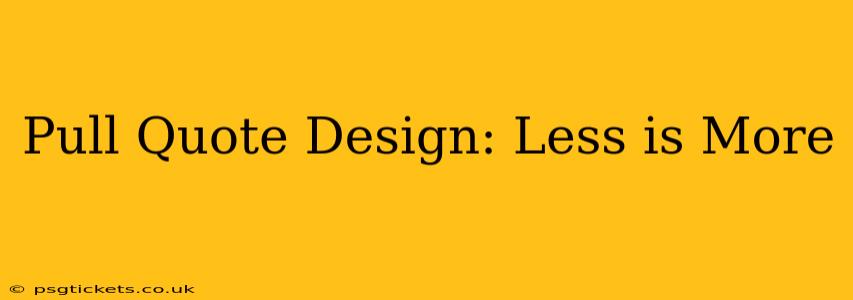Pull quotes—those snippets of text pulled from the body of an article and visually emphasized—are powerful tools for enhancing readability and grabbing the reader's attention. But effective pull quote design isn't about throwing in as many as possible; it's about strategic placement and minimalist aesthetics. The key to successful pull quote design is embracing the philosophy of "less is more."
Why Use Pull Quotes?
Before diving into design, let's reiterate the core benefits of using pull quotes:
- Improved Readability: They break up large blocks of text, making the article feel less daunting and more inviting to read.
- Enhanced Visual Appeal: A well-designed pull quote adds visual interest to the page, preventing the text from becoming monotonous.
- Highlighting Key Information: They strategically emphasize the most important points or most compelling statements within your writing.
- Increased Engagement: They act as visual anchors, encouraging readers to pause and absorb the highlighted message.
The Principles of Minimalist Pull Quote Design
Effective pull quote design hinges on several key principles:
-
Strategic Selection: Don't pull every interesting sentence. Choose only the most impactful statements that truly summarize the article's core message or provide a compelling takeaway. Overuse dilutes their impact.
-
Appropriate Font: Select a font that contrasts subtly but effectively with the body text. A slightly bolder weight or a different but complementary typeface can work well. Avoid excessively ornate or difficult-to-read fonts. Legibility is paramount.
-
Size and Spacing: The pull quote should be noticeably larger than the surrounding text, but not so large that it overwhelms the page layout. Sufficient white space around the quote is crucial to ensure it stands out without being cluttered.
-
Color Palette: Stick to your overall brand's color scheme. A subtle color change—perhaps a slightly darker shade of your primary color or a complementary accent—can be effective, but avoid anything jarring or distracting.
-
Placement: Consider where the pull quote best supports the flow of the article. It should ideally appear near the section of text it's pulled from, but not directly interrupting the natural reading rhythm.
-
Minimalist Styling: Avoid excessive embellishments like drop shadows, heavy borders, or intricate background textures. A clean, uncluttered look allows the quote itself to shine.
Common Mistakes to Avoid
Several design choices can undermine the effectiveness of your pull quotes:
-
Too Many Quotes: Overusing pull quotes diminishes their impact and can create a cluttered, distracting reading experience.
-
Poor Font Choices: Illegible or overly stylized fonts make the quote difficult to read, negating its purpose.
-
Inadequate Spacing: Crowding the quote with surrounding text makes it blend in rather than stand out.
-
Clashing Colors: A pull quote that clashes visually with the rest of the page is distracting and unprofessional.
How to Create Effective Pull Quotes
The process of designing a pull quote is relatively straightforward:
-
Choose Your Quote: Carefully select the most compelling and impactful statement.
-
Select Your Font: Opt for a legible and complementary font.
-
Determine the Size and Spacing: Ensure adequate size and spacing for visual impact and readability.
-
Choose a Subtle Color (if applicable): Consider a subtle color variation to enhance visual appeal without distraction.
-
Place Strategically: Integrate the quote seamlessly within the text flow.
Frequently Asked Questions
What is the best font size for a pull quote?
There's no single "best" font size. It depends on the overall design and font used for the body text. Aim for a size that's noticeably larger (1.5 to 2 times larger) than the body text but still maintains readability.
Should I use a different font for pull quotes?
You can use a different font, but it should be visually complementary to your body text. A slight variation in weight or style is often sufficient. Avoid drastically different fonts that clash.
How many pull quotes should I use per article?
The ideal number depends on the length and complexity of the article. Generally, 1-3 pull quotes are sufficient for most articles. More than that risks diluting their effectiveness.
Where should I place pull quotes in my article?
Place them near the section of text they're taken from but strategically, to avoid interrupting the flow. Consider the visual balance of the page and how the quote enhances the overall layout.
By adhering to the principle of "less is more," you can leverage pull quotes to enhance the visual appeal and readability of your content, leaving a lasting impact on your readers. Remember, it's about quality, not quantity.

